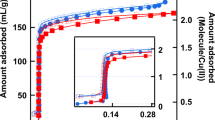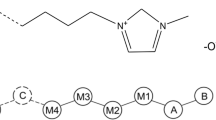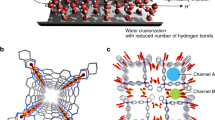Abstract
Ionic liquids are composed of equal quantities of positive and negative ions. In the bulk, electrical neutrality occurs in these liquids due to Coulombic ordering, in which ion shells of alternating charge form around a central ion. Their structure under confinement is far less well understood. This hinders the widespread application of ionic liquids in technological applications. Here we use scattering experiments to resolve the structure of a widely used ionic liquid (EMI–TFSI) when it is confined inside nanoporous carbons. We show that Coulombic ordering reduces when the pores can accommodate only a single layer of ions. Instead, equally charged ion pairs are formed due to the induction of an electric potential of opposite sign in the carbon pore walls. This non-Coulombic ordering is further enhanced in the presence of an applied external electric potential. This finding opens the door for the design of better materials for electrochemical applications.
This is a preview of subscription content, access via your institution
Access options
Access Nature and 54 other Nature Portfolio journals
Get Nature+, our best-value online-access subscription
$29.99 / 30 days
cancel any time
Subscribe to this journal
Receive 12 print issues and online access
$259.00 per year
only $21.58 per issue
Buy this article
- Purchase on Springer Link
- Instant access to full article PDF
Prices may be subject to local taxes which are calculated during checkout






Similar content being viewed by others
References
Impey, R. W., Madden, P. A. & McDonald, I. R. Hydration and mobility of ions in solution. J. Phys. Chem. 87, 5071–5083 (1983).
Jungwirth, P. & Tobias, D. J. Specific ion effects at the air/water interface. Chem. Rev. 106, 1259–1281 (2006).
Chmiola, J. et al. Anomalous increase in carbon capacitance at pore sizes less than 1 nanometer. Science 313, 1760–1763 (2006).
Ohkubo, T. et al. Restricted hydration structures of Rb and Br ions confined in slit-shaped carbon nanospace. J. Am. Chem. Soc. 124, 11860–11861 (2002).
Huang, J., Sumpter, B. G. & Meunier, V. Theoretical model for nanoporous carbon supercapacitors. Angew. Chem. Int. Ed. 47, 520–524 (2008).
Tanaka, A. et al. Effect of a quaternary ammonium salt on propylene carbonate structures in slit-shape carbon nanospaces. J. Am. Chem. Soc. 132, 2112–2113 (2010).
Fukano, M. et al. Vertically oriented propylene carbonate molecules and tetraethyl ammonium ions in carbon slit pores. J. Phys. Chem. C 117, 5752–5757 (2013).
Deschamps, M. et al. Exploring electrolyte organization in supercapacitor electrodes with solid-state NMR. Nat. Mater. 12, 351–358 (2013).
Boukhalfa, S., He, L., Melnichenko, Y. B. & Yushin, G. Small-angle neutron scattering for in situ probing of ion adsorption inside micropores. Angew. Chem. Int. Ed. 52, 4618–4622 (2013).
Forse, A. C. et al. Nuclear magnetic resonance study of ion adsorption on microporous carbide-derived carbon. Phys. Chem. Chem. Phys. 15, 7722–7730 (2013).
Levi, M. D., Sigalov, S., Aurbach, D. & Daikhin, L. In situ electrochemical quartz crystal admittance methodology for tracking compositional and mechanical changes in porous carbon electrodes. J. Phys. Chem. C 117, 14876–14889 (2013).
Merlet, C. et al. Highly confined ions store charge more efficiently in supercapacitors. Nat. Commun. 4, 2701 (2013).
Prehal, C. et al. Quantification of ion confinement and desolvation in nanoporous carbon supercapacitors with modelling and in situ X-ray scattering. Nat. Energy 2, 16215 (2017).
Fedorov, M. V. & Kornyshev, A. A. Ionic liquids at electrified interfaces. Chem. Rev. 114, 2978–3036 (2014).
Kornyshev, A. A. Double-layer in ionic liquids: paradigm change? J. Phys. Chem. B 111, 5545–5557 (2007).
Hayes, R., Warr, G. G. & Atkin, R. Structure and nanostructure in ionic liquids. Chem. Rev. 115, 6357–6426 (2015).
Armand, M., Endres, F., MacFarlane, D. R., Ohno, H. & Scrosati, B. Ionic-liquid materials for the electrochemical challenges of the future. Nat. Mater. 8, 621–629 (2009).
Bañuelos, J. L. et al. Densification of ionic liquid molecules within a hierarchical nanoporous carbon structure revealed by small angle scattering and molecular dynamics simulation. Chem. Mater. 26, 1144–1153 (2014).
Tsai, W. Y., Taberna, P. L. & Simon, P. Electrochemical quartz crystal microbalance (EQCM) study of ion dynamics in nanoporous carbons. J. Am. Chem. Soc. 136, 8722–8728 (2014).
Richey, F. W., Dyatkin, B., Gogotsi, Y. & Elabd, Y. A. Ion dynamics in porous carbon electrodes in supercapacitors using in situ infrared spectroelectrochemistry. J. Am. Chem. Soc. 135, 12818–12826 (2013).
Forse, A. C. et al. NMR study of ion dynamics and charge storage in ionic liquid supercapacitors. J. Am. Chem. Soc. 137, 7231–7241 (2015).
Mezger, M. et al. Molecular layering of fluorinated ionic liquids at a charged sapphire (0001) surface. Science 17, 424–428 (2008).
Perkin, S. Ionic liquids in confined geometries. Phys. Chem. Chem. Phys. 14, 5052–5062 (2012).
Bazant, M. Z., Storey, B. D. & Kornyshev, A. A. Double layer in ionic liquids: overscreening versus crowding. Phys. Rev. Lett. 106, 046102 (2011).
Merlet, C. et al. On the molecular origin of supercapacitance in nanoporous carbon electrodes. Nat. Mater. 11, 306–310 (2012).
Péan, C. et al. On the dynamics of charging in nanoporous carbon-based supercapacitors. ACS Nano 8, 1576–1583 (2014).
Feng, G. & Cummings, P. T. Supercapacitor capacitance exhibits oscillatory behavior as a function of nanopore size. J. Phys. Chem. Lett. 2, 2859–2864 (2011).
Kondrat, S. & Kornyshev, A. A. Superionic state in double-layer capacitors with nanoporous electrodes. J. Phys. Condens. Matter 23, 022201 (2011).
Simon, P. & Gogotsi, Y. Materials for electrochemical capacitors. Nat. Mater. 7, 845–854 (2008).
Lin, R. et al. Solvent effect on the ion adsorption from ionic liquid electrolyte into subnanometer carbon pores. Electrochim. Acta 54, 7025–7032 (2009).
Kondrat, S., Wu, P., Qiao, R. & Kornyshev, A. A. Accelerating charging dynamics in subnanometre pores. Nat. Mater. 13, 387–393 (2014).
Porada, S., Zhao, R., van der Wal, A., Presser, V. & Biesheuvel, P. M. Review on the science and technology of water desalination by capacitive deionization. Prog. Mater. Sci. 58, 1388–1442 (2013).
Brogioli, D. Extracting renewable energy from a salinity difference using a capacitor. Phys. Rev. Lett. 103, 059501 (2009).
Petersen, T. C., Yarovsky, I., Snook, I. K., McCulloch, D. G. & Opletal, G. Structural analysis of carbonaceous solids using an adapted Reverse Monte Carlo algorithm. Carbon 41, 2403–2411 (2003).
Palmer, J. C. et al. Modeling the structural evolution of carbide-derived carbons using quenched molecular dynamics. Carbon 48, 1116–1123 (2010).
Kondrat, S., Georgi, N., Fedorov, M. V. & Kornyshev, A. A. A superionic state in nano-porous double-layer capacitors: insights from Monte Carlo simulations. Phys. Chem. Chem. Phys. 13, 11359–11366 (2011).
Choudhury, A. R., Winterton, N., Steiner, A., Cooper, A. I. & Johnson, K. A. In situ crystallization of ionic liquids with melting points below −25 °C. Cryst. Eng. Commun. 8, 742–745 (2006).
Iiyama, T. et al. Molecular assembly structure of CCl4 in graphitic nanospaces. J. Phys. Chem. B 101, 3037–3042 (1997).
Fujii, K. et al. Liquid structure of room-temperature ionic liquid, 1-ethyl-3-methylimidasolium bis-(trifluoromethanesulfonyl) imide. J. Phys. Chem. B 112, 4329–4336 (2008).
Hettige, J. J., Kashyap, H. K., Annapureddy, H. V. R. & Margulis, C. J. Anion, the reporters of structure in ionic liquids. J. Phys. Chem. Lett. 4, 105–110 (2013).
Canongia Lopes, J. N. & Padua, A. A. H. Nanostructural organization of ionic liquids. J. Phys. Chem. B 110, 3330–3335 (2006).
Maolin, S. et al. Ordering layers of [bmim][PF6] ionic liquid on graphite surfaces: molecular dynamics simulation. J. Chem. Phys. 128, 134504 (2008).
Weingärtner, H. S. The static dielectric constant of ionic liquids. Z. Phys. Chem. 220, 1395–1405 (2006).
Cho, M. H. & Silbey, R. J. Suppression and enhancement of van der Waals interactions. J. Chem. Phys. 104, 8730–8741 (1996).
Rochester, C. C., Lee, A. A., Pruessner, G. & Kornyshev, A. A. Interionic interactions in conducting nanoconfinement. ChemPhysChem 14, 4121–4125 (2013).
Zhong, Y. et al. Transition metal carbides and nitrides in energy storage and conversion. Adv. Sci. 3, 1500286 (2016).
Allen, M. P. & Tildesley, D. Computer Simulation of Liquids (Clarendon, 1987).
Steele, W. A. The physical interaction of gases with crystalline solids: I. Gas-solid energies and properties of isolated adsorbed atoms. Surf. Sci. 36, 317–352 (1973).
Presser, V., Heon, M. & Gogotsi, Y. Carbide-derived carbons - from porous networks to nanotubes and graphene. Adv. Funct. Mater. 21, 810–833 (2011).
Lopes, J. N. C. & Padua, A. A. H. CL&P: a generic and systematic force field for ionic liquids modeling. Theor. Chem. Acc. 131, 1129–1140 (2012).
Acknowledgements
R.F. is supported by TAKAGI Co., Ltd. This research was supported by Grant-in-Aid for Young Scientists (B) (No. 26870240), Young Scientists (A) (No. 17H04953), Scientific Research (A) (No. 24241038), Scientific Research (B) (No. 17H03039), CREST (JPMJCR1324) and Center of Innovation Program from Japan Science and Technology Agency. The synchrotron radiation experiments were performed at the BL02B2 of SPring-8 with the approval of the Japan Synchrotron Radiation Research Institute (JASRI) (Proposal No. 2012B1438, No. 2013B1243, No.2014A1167 and No. 2014B1196) and at the BL5S2 of Aichi Synchrotron Radiation Center, Aichi Science & Technology Foundation, Aichi, Japan (Approval No. 2016D4005 and No. 201606124). P.S. acknowledges support from the European Research Council under the European Union’s Seventh Framework Programme (FP/2007-2013) / ERC Grant Agreement n.102539 (Advanced Grant, Ionaces project). M.J.B. acknowledges the support of the Australian Research Council Discovery Program (DP110101293). Y.G. work on CDC was supported by the Fluid Interface Reactions, Structures & Transport, an Energy Frontier Research Center funded by the US Department of Energy, Office of Science, Office of Basic Energy Sciences. We are also grateful to K. Van Aken (Drexel University) for providing additional CDC samples.
Author information
Authors and Affiliations
Contributions
R.F. carried out the experiments, being in main charge of this research. R.F., P.S. and K.K. prepared the manuscript. T.I. developed the HRMC simulation program and supported the structure analysis. M.J.B. supported development of the HRMC program. M.S. computed image charge distributions. R.F. and Y.T. performed HRMC calculations. P.S. and Y.G. provided the CDC samples. J.S. contributed development of in situ X-ray diffraction measurements. R.F., M.S., T.I., P.S., Y.G., M.J.B. and K.K. discussed the results and edited the paper.
Corresponding authors
Ethics declarations
Competing interests
The authors declare no competing financial interests.
Supplementary information
Supplementary Information
Supplementary Information (PDF 2051 kb)
Rights and permissions
About this article
Cite this article
Futamura, R., Iiyama, T., Takasaki, Y. et al. Partial breaking of the Coulombic ordering of ionic liquids confined in carbon nanopores. Nature Mater 16, 1225–1232 (2017). https://doi.org/10.1038/nmat4974
Received:
Accepted:
Published:
Issue Date:
DOI: https://doi.org/10.1038/nmat4974
This article is cited by
-
Vertical iontronic energy storage based on osmotic effects and electrode redox reactions
Nature Energy (2024)
-
Crystallization of molecular layers produced under confinement onto a surface
Nature Communications (2024)
-
Review of the role of ionic liquids in two-dimensional materials
Frontiers of Physics (2023)
-
Bionic iontronics based on nano-confined structures
Nano Research (2023)
-
Continuous transition from double-layer to Faradaic charge storage in confined electrolytes
Nature Energy (2022)



